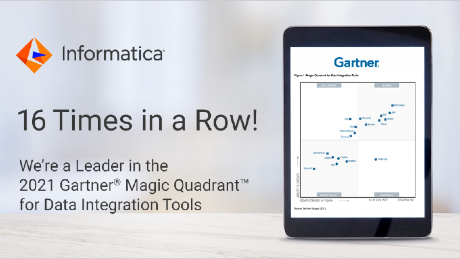Why We’re a 16-Time Leader in the Gartner Magic Quadrant for Data Integration Tools
Here’s what this recognition means to us
Here’s what this recognition means to us

Gartner recently released its 2021 Gartner® Magic Quadrant™ for Data Integration Tools. It’s extremely gratifying to note our positioning—which is furthest to the right for completeness of vision and highest for ability to execute. A position like this does not come easy. And certainly not year after year. In our view, it’s the result of relentless innovation and focus. All of which is something we at Informatica are very proud of. We believe this acknowledges that our ETL, ELT and data integration capabilities are positioned to serve our customers on their digital transformation journey.
But let’s take a step back. Why is data integration so important? Why is this Gartner Magic Quadrant so meaningful?
Data Integration Market Trends
Your ability to grow and transform depends on insights from modern cloud analytics, putting data integration at the center of your digital transformation. With increasing data volume, data coming in from a variety of sources, multi-cloud, multi-hybrid, and growing numbers of data consumers across the organization, integration is more important than ever. According to Gartner, “By 2025, more than 75% of the midsize, large and global organizations will establish integration strategy empowerment teams to support collaborative integration, up from 40% in 2021.” [1]
At the same time that data integration is growing in importance, it’s also getting more complex, which means you need an integration partner who can support the widest range of use cases with the most advanced capabilities.
Informatica pioneered traditional ETL (extract transform load) with Informatica PowerCenter. In the old world of star schema databases, you ingested data from on-premises sources like enterprise applications or databases into an on-premises data warehouse and transformed it so it could be used for analytics.
Today you have methods like cloud ELT (extract, load, transform – also known as cloud pushdown optimization), cloud ETL, and Spark processing. The move to cloud has changed the way that organizations approach data management. But, just as it did in the on-premises world, Informatica provides the most advanced and most comprehensive cloud data integration for your analytics needs.
Informatica Data Integration Strengths
We’re proud of our positioning in the 2021 Gartner Magic Quadrant for Data Integration Tools. In our view, it reflects the major innovative accomplishments of the past year, notably our introduction of the Informatica Intelligent Data Management Cloud – the industry’s first and most comprehensive cloud-native, AI-powered end-to-end data management platform delivering intelligent cloud services.
Our history of innovation enables us to deliver:
- The industry’s most comprehensive metadata-driven intelligence for an intelligent data fabric: Informatica CLAIRE – our metadata-driven AI and machine-learning engine – provides the industry’s most comprehensive metadata-driven intelligence for cloud data management. With CLAIRE-powered recommendations and automation, you can achieve faster, most cost-effective data integration to power your digital transformation.
- The most scalable, high-performance, and cost-effective data integration capabilities: Our cloud data integration services provide built-in performance and cost optimization features that address the costs, complexity, and resource constraints that can impede modern integration initiatives. Tackle any integration use case with pushdown optimization (ELT), elastic Spark, serverless, and ETL capabilities – delivered via one comprehensive platform: the Intelligent Data Management Cloud.
- The widest range of capabilities for any data integration use case and data consumer: As data grows in strategic importance, integration becomes a capability that must extend beyond your data engineers and data scientists. Our integration solutions enable both technical and non-technical teams to easily build data pipelines, collaborate, and share trusted data across the enterprise. And we help you increase business resiliency and fuel data democratization by enabling you to implement data hubs and data marketplaces across multi-cloud and multi-hybrid environments.
I hope you’ll download your complimentary copy of the 2021 Gartner Magic Quadrant for Data Integration Tools to learn more about our data integration strengths in cloud-native ELT and ETL.
Sources:
[1] Gartner, Ensure Your Integration Strategy Supports Modern Integration Trends, Abhishek Singh, Eric Thoo et al, 23 February 2021
Gartner Magic Quadrant for Data Integration Tools, Ehtisham Zaidi, Robert Thanaraj, Eric Thoo, Sharat Menon, Nina Showell, August 25, 2021
Gartner does not endorse any vendor, product or service depicted in its research publications, and does not advise technology users to select only those vendors with the highest ratings or other designation. Gartner research publications consist of the opinions of Gartner’s research organization and should not be construed as statements of fact. Gartner disclaims all warranties, expressed or implied, with respect to this research, including any warranties of merchantability or fitness for a particular purpose.
GARTNER and Magic Quadrant are a registered trademark and service are mark of Gartner, Inc. and/or its affiliates in the U.S. and internationally and are used herein with permission. All rights reserved.


May 31, 2023
May 31, 2023







